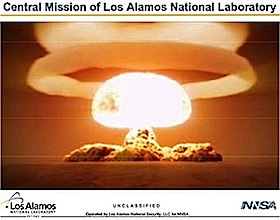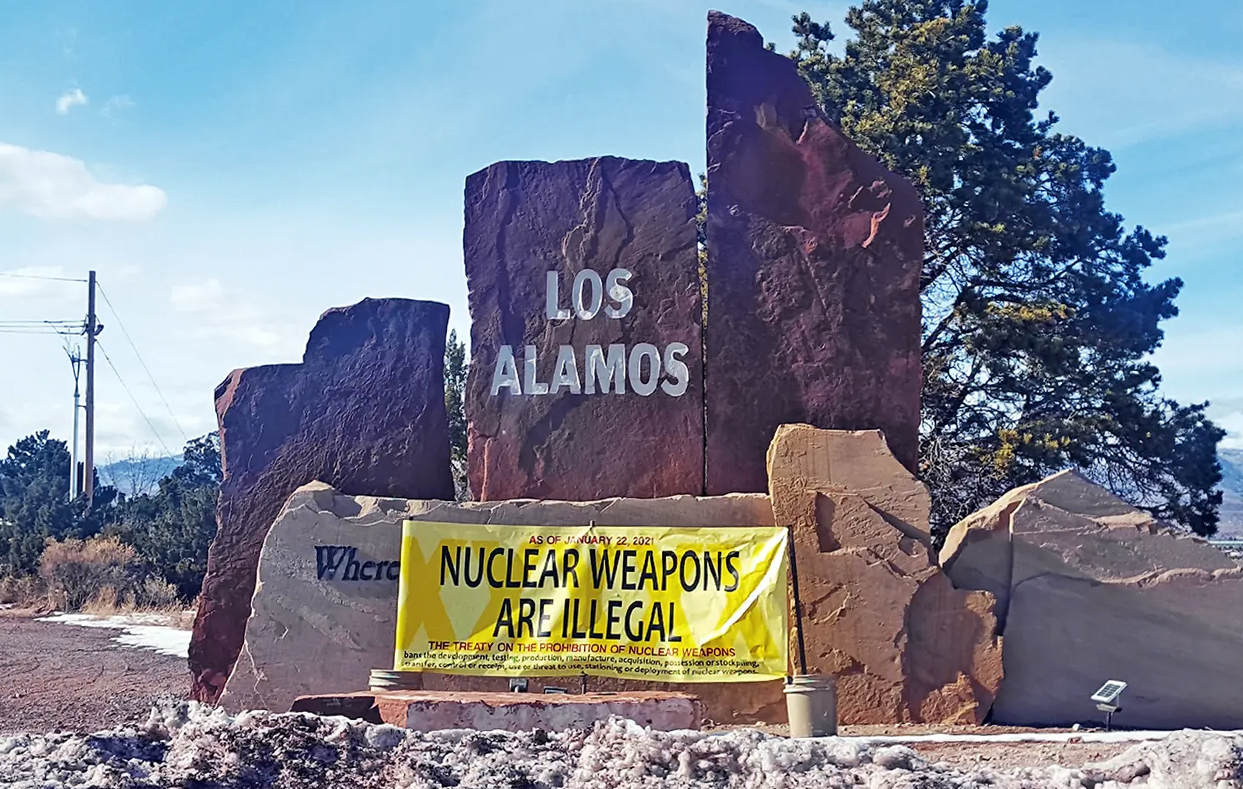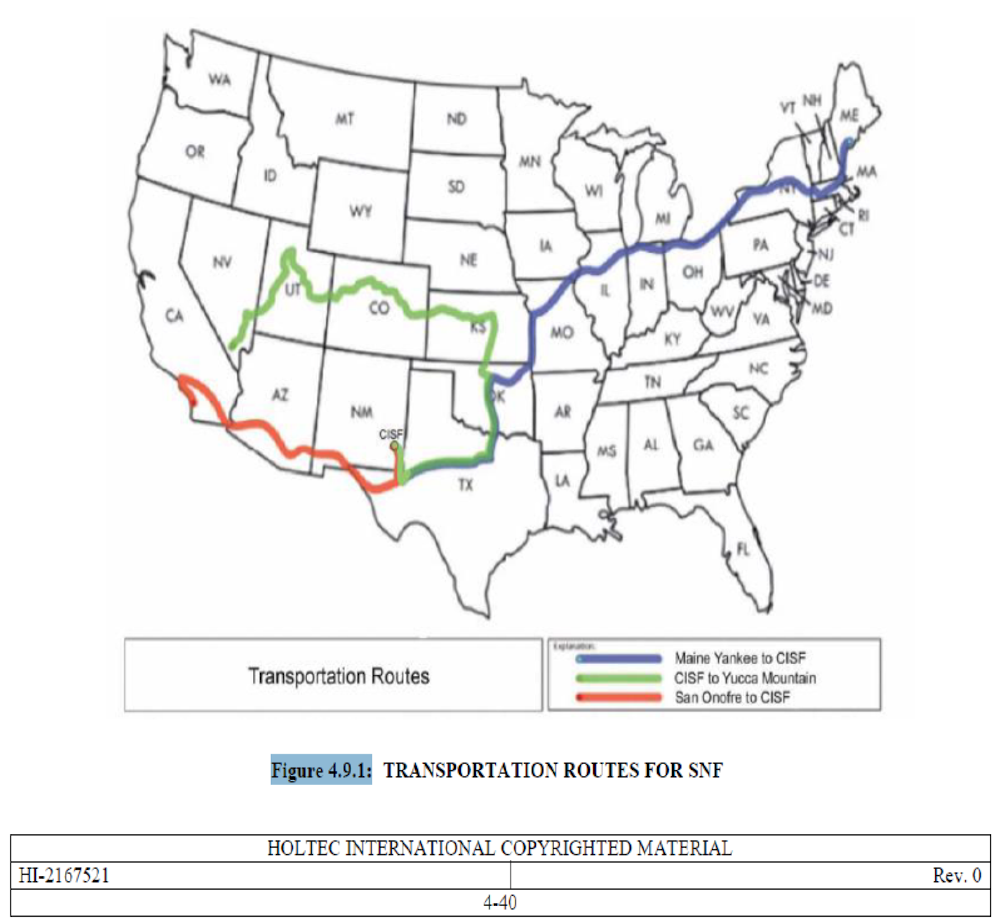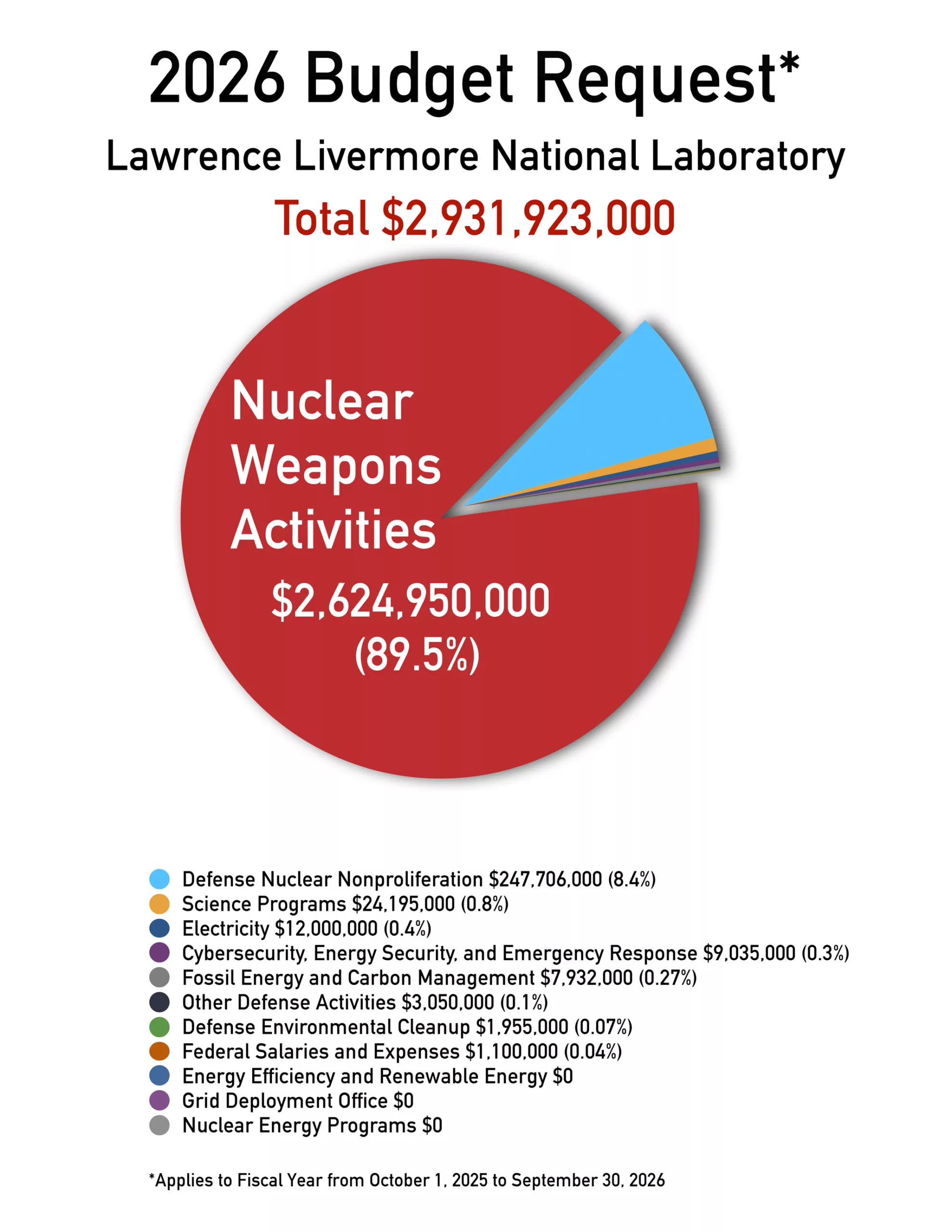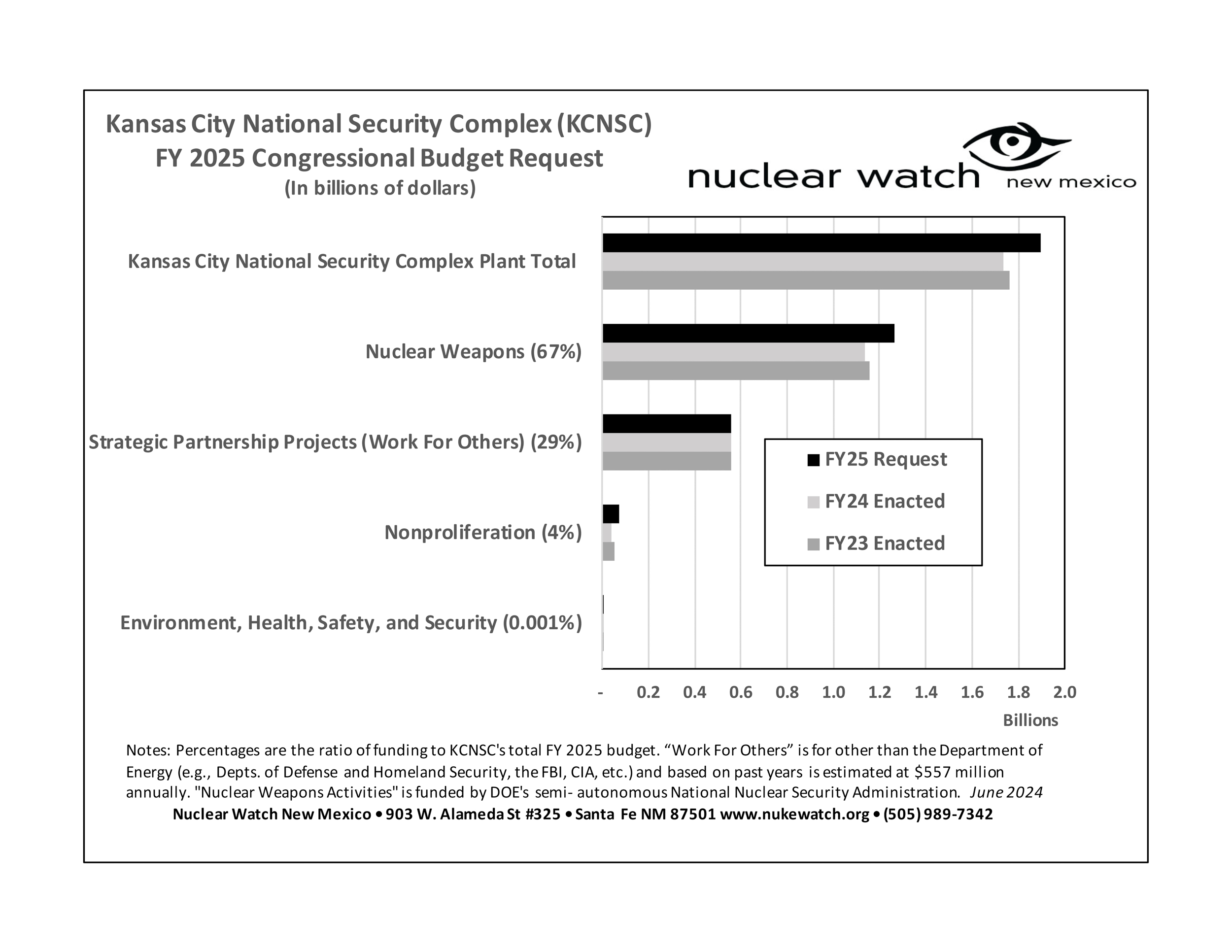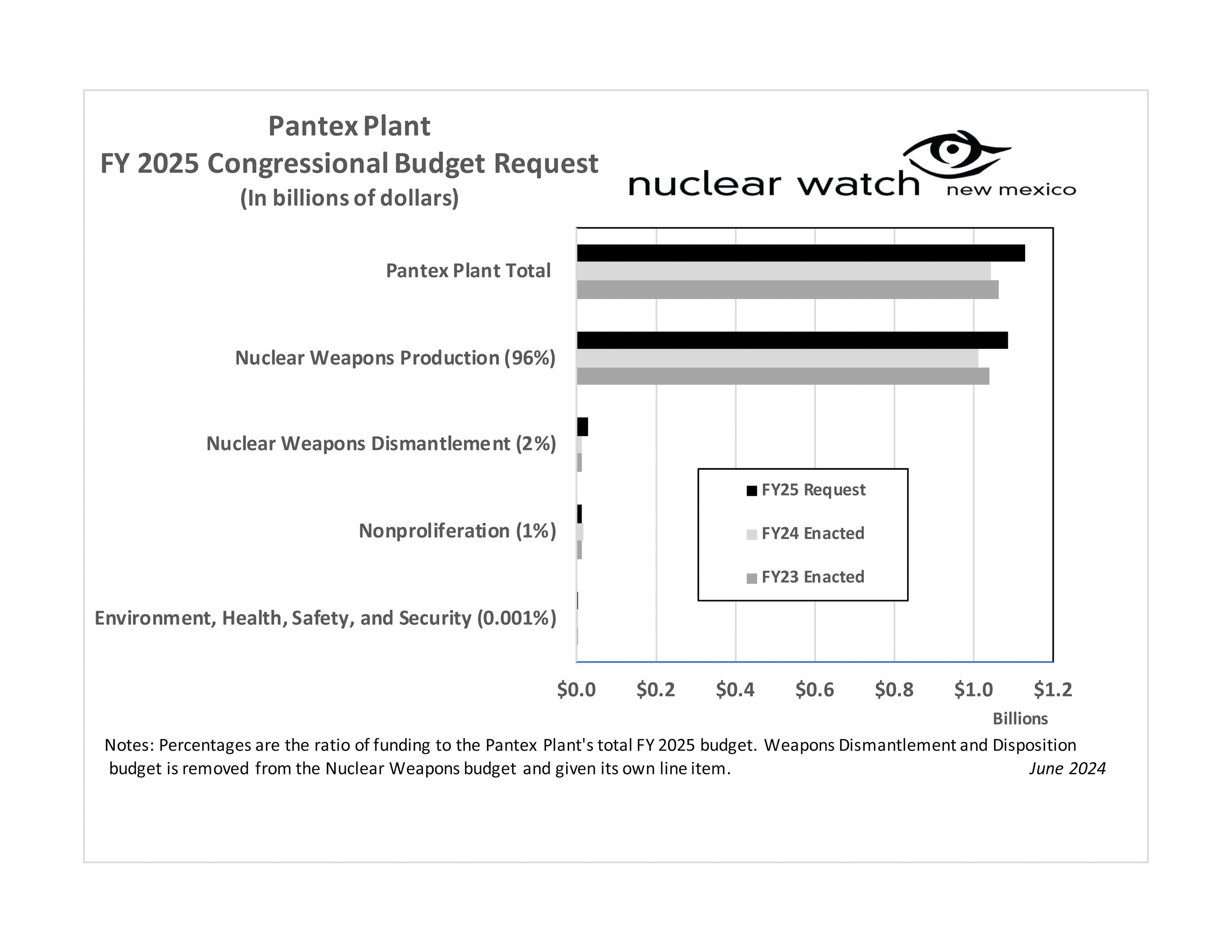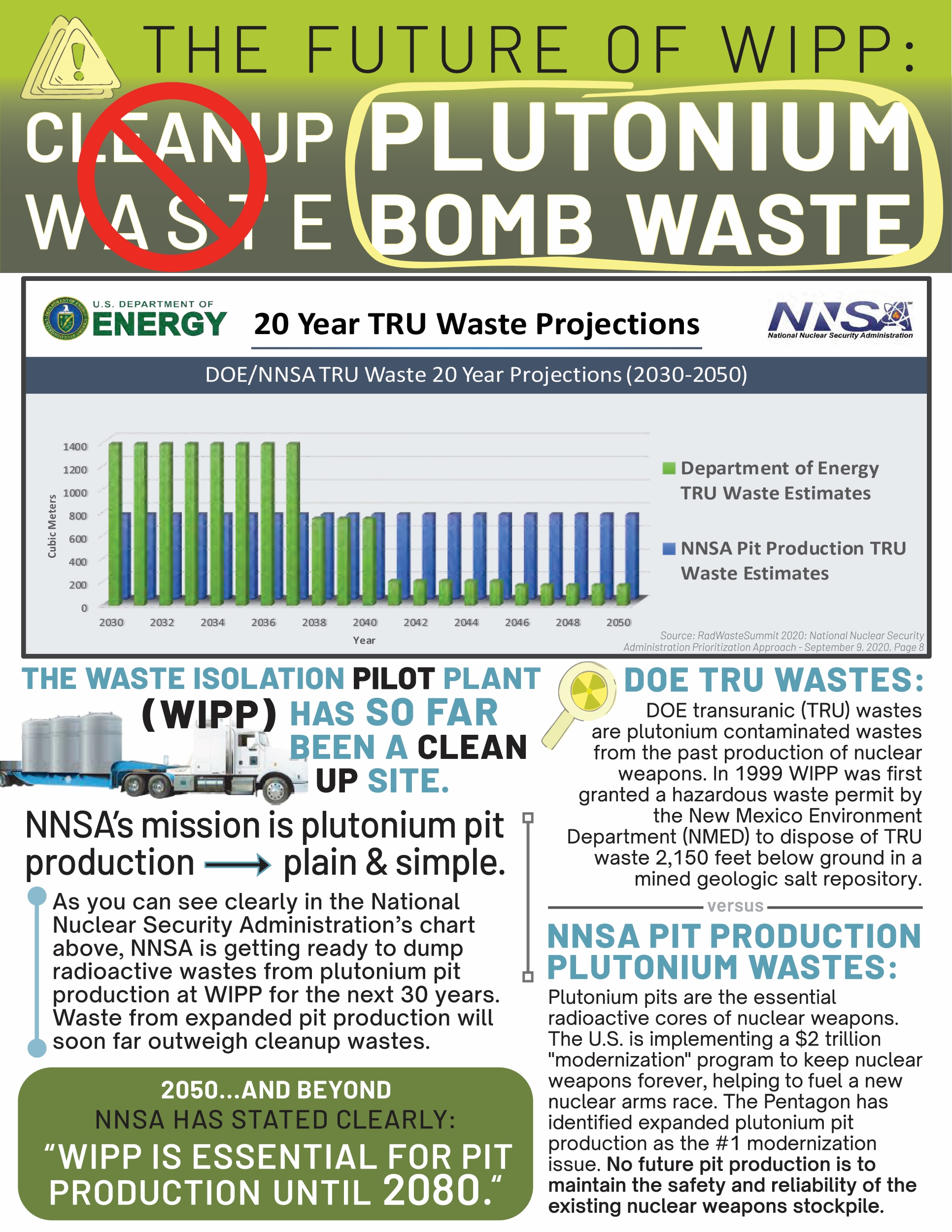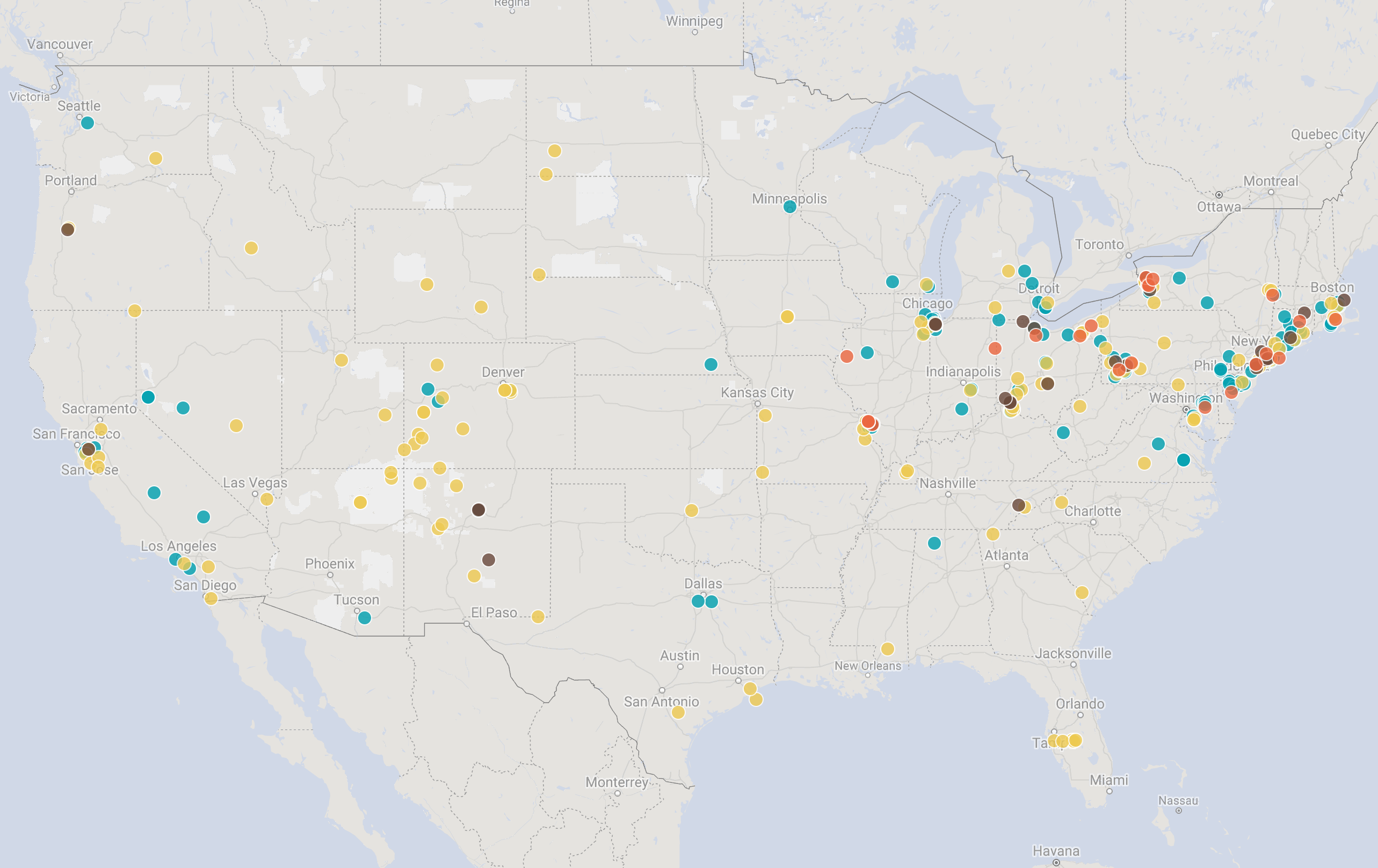QUOTE OF THE WEEK
Nothing Found
It seems we can’t find what you’re looking for. Perhaps searching can help.
LANL’s Central Mission: Los Alamos Lab officials have recently claimed that LANL has moved away from primarily nuclear weapons to “national security”, but what truly remains as the Labs central mission? Here’s the answer from one of its own documents:
LANL’s “Central Mission”- Presented at: RPI Nuclear Data 2011 Symposium for Criticality Safety and Reactor Applications (PDF) 4/27/11
Banner displaying “Nuclear Weapons Are Now Illegal” at the entrance in front of the Los Alamos National Lab to celebrate the Entry Into Force of the Nuclear Weapon Ban Treaty on January 22, 2021
Nothing Found
It seems we can’t find what you’re looking for. Perhaps searching can help.
Follow the Money!
Livermore FY26 Budget Request (Courtesy of Tri-Valley CAREs)
Map of “Nuclear New Mexico”
In 1985, US President Ronald Reagan and Russian President Mikhail Gorbachev declared that “a nuclear war cannot be won and must never be fought.”

NEW & UPDATED
Fallout from a nuclear past: A new book explores the human toll of “nuclear colonization” in New Mexico
Of the three waves of colonization New Mexico has undergone — Spanish, American and nuclear — the latter is the least explored. And for author Myrriah Gómez, there were personal reasons to reveal the truth about how “nuclear colonization” has altered the state’s past and continues to shape its future.
By Alicia Inez Guzmán Searchlight New Mexico | December 2022 searchlightnm.org
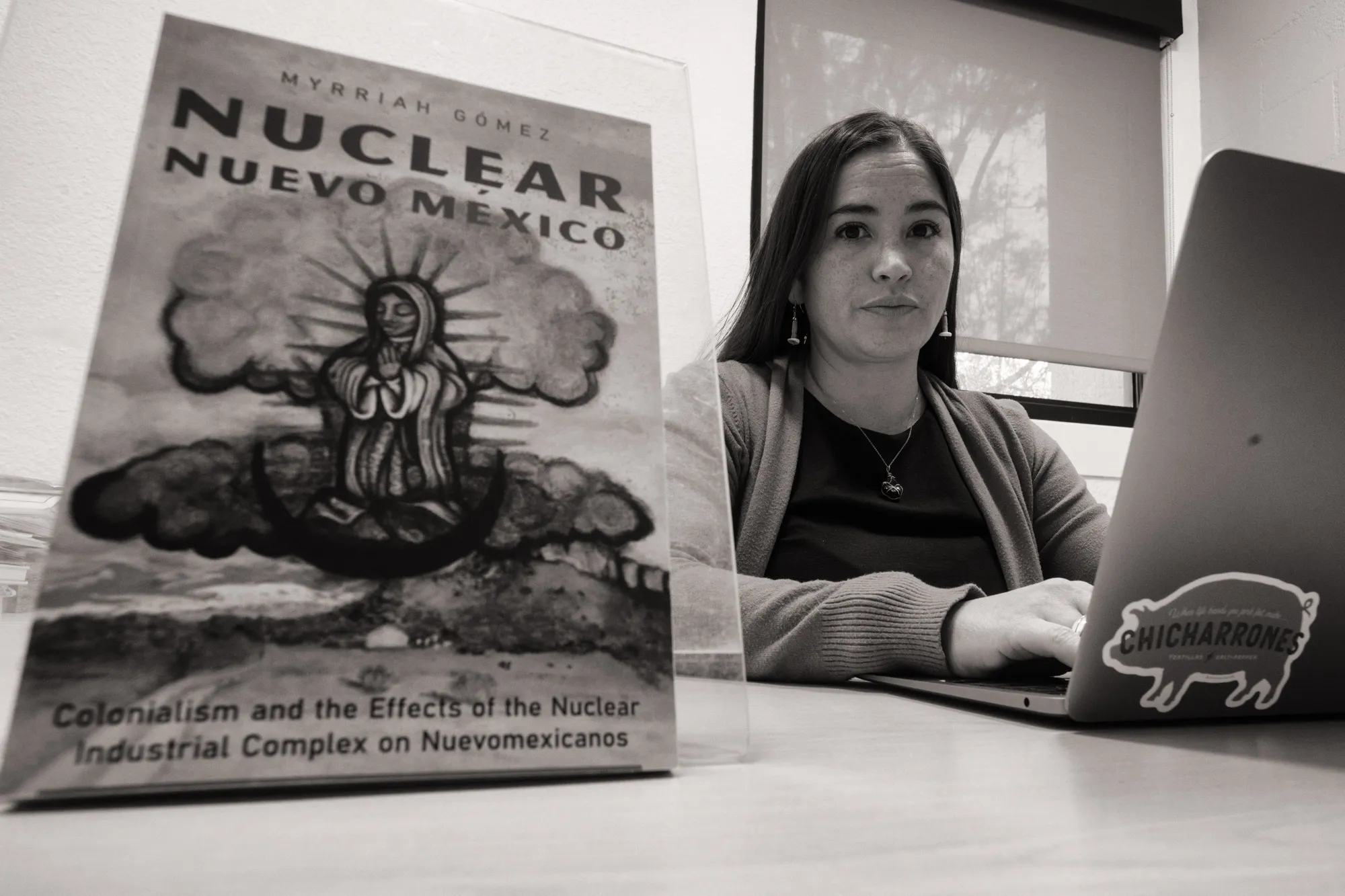 Gómez, an assistant professor at the University of New Mexico, is the author of “Nuclear Nuevo México,” a book that explores the history of the Los Alamos National Laboratory and the fundamental tension of living in its shadow. Its publication this month by the University of Arizona Press couldn’t be timelier: Los Alamos is currently preparing to build plutonium “pits” that act as triggers in nuclear weapons, putting the lab front and center in an ongoing national debate about nuclear impacts.
Gómez, an assistant professor at the University of New Mexico, is the author of “Nuclear Nuevo México,” a book that explores the history of the Los Alamos National Laboratory and the fundamental tension of living in its shadow. Its publication this month by the University of Arizona Press couldn’t be timelier: Los Alamos is currently preparing to build plutonium “pits” that act as triggers in nuclear weapons, putting the lab front and center in an ongoing national debate about nuclear impacts.
“If Spanish colonialism brought Spanish colonizers and U.S. colonialism brought American colonizers,” as Gómez writes in her book, “then nuclear colonialism brought nuclear colonizers, scientists, military personnel, atomic bomb testing, and nuclear waste among them.”
Ukraine still fears another Chernobyl-size disaster at Europe’s largest nuclear plant
“Why did they say it was safe to go outdoors? Why did they build it so close to Kyiv?…Why was it all such a secret?” – Yuriy Samoilenko, chief environmental inspector at Kyiv’s city hall at the time of the Chernobyl meltdown.
By JULIAN HAYDA, NPR | December 11, 2022 npr.org
CHERNOBYL, Ukraine — Sophia Arkadiyivna remembers when the Soviet Union built the Chernobyl Nuclear Power Plant in 1977, just 20 miles from the village where she served as mayor.
After years of atomic energy powering big Russian cities like Moscow, Leningrad and Voronezh, the USSR was finally ready to expand the technology to other Soviet republics like Ukraine. Soviet propaganda promised easier jobs and cleaner air.
“We didn’t have a reason to distrust the government. They showed us how good things could be,” she says.
Or so she thought at the time. It didn’t take long for Arkadiyivna to turn skeptical.
Nuclear waste permit ‘more stringent’ New Mexico says as feds look to renew for 10 years
NMED Cabinet Secretary James Kenney said the State wanted a permit with stronger regulations moving forward, to better protect people and the environment from the impacts of nuclear waste disposal.
“It will be more stringent, full stop,” Kenney said. “The conditions were adding to it are designed to add more accountability to the whole complex that are sending waste to WIPP.”
By Adrian Hedden, Carlsbad Current-Argus | December 10, 2022 currentargus.com
 Tougher rules for a nuclear waste repository near Carlsbad could be on the way as New Mexico officials sought “more stringent” regulations as the federal government sought to renew its permit with the state for the facility.
Tougher rules for a nuclear waste repository near Carlsbad could be on the way as New Mexico officials sought “more stringent” regulations as the federal government sought to renew its permit with the state for the facility.
The State sought new requirements to prioritize nuclear waste from within New Mexico for disposal, called for an accounting of all of the waste planned for disposal in the next decade and regular updates on federal efforts to find the location for a new repository as conditions of the permit.
The Waste Isolation Pilot Plant is owned by the U.S. Department of Energy which holds a permit with the New Mexico Environment Department (NMED) that must be updated every 10 years.
The facility sees transuranic (TRU) nuclear waste from DOE facilities around the country disposed of via burial in an underground salt formation about 2,000 feet beneath the surface.
The Bizarre Mystery of the Only Armed Nuke America Ever Lost
The lost nuke has never been found—only the pilot’s helmet was recovered, and the government kept it secret for years.
By Matthew Gault, Vice News | 2022 vice.com
In the early days of the Cold War, the United States wanted to make sure it could launch a retaliatory strike against the Soviet Union as quickly as possible if it launched a nuclear strike. The goal was 15 minutes. This was before the advent of submarines that launch ballistic missiles and intercontinental ballistic missile silos. From 1960 until 1968, America maintained that 15-minute ability to pepper the globe with nukes by putting pilots on 24-hour alert. For more than a decade, hundreds of U.S. pilots criss-crossed the planet in planes loaded with nuclear bombs. To keep up with brutal hours, many of the pilots and crew took amphetamine.
As noted in Task & Purpose, the U.S. military had 32 nuclear accidents during the Cold War, and six of the weapons are still unaccounted for. Every story of a Broken Arrow—the military term for a missing nuke—is harrowing, but what happened off the coast of Japan in 1965 was especially frightening.
On December 5, 1965, U.S. Navy Lt. Douglas Webster was supposed take an A-4E Skyhawk loaded with a nuclear bomb into the sky. On the USS Ticonderoga aircraft carrier, stationed in the Philippine Sea about 70 miles from Okinawa, Japan, the crew loaded the weapon onto the vehicle and Webster got into the cockpit. The crew then pushed the plane to an elevator that would bring it up to the flight deck.
Watch a brief YouTube Clip about this event:
Making the Case That Nuclear Weapons Are Immoral: An Interview With Archbishop John C. Wester
If nuclear weapons are ever eliminated, it will be the result of actions big and small at every communal level, from international leaders to civil society.
Arms Control Association | December 2022 armscontrol.org
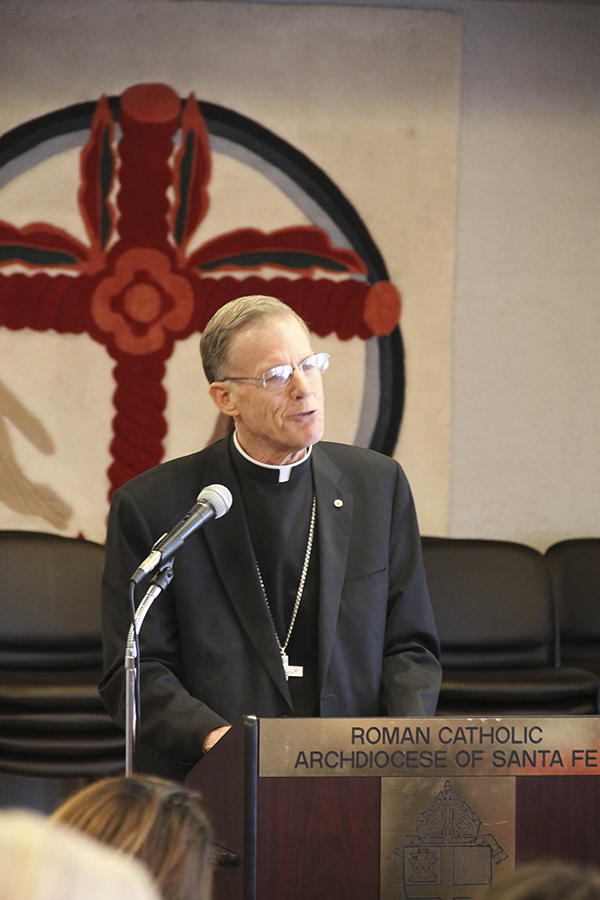
The Reverend John C. Wester occupies a unique role in this continuum as the Roman Catholic archbishop of Santa Fe, whose archdiocese is home to the Los Alamos and Sandia national nuclear laboratories and site of the first Manhattan Project nuclear tests. In January, Wester issued a pastoral letter, “Living in the Light of Christ’s Peace: A Conversation Toward Nuclear Disarmament,” which called for the abolition of nuclear weapons and declared that the archdiocese “must be part of a strong peace initiative.” He had a compelling basis for action: In 2021, Pope Francis shifted the church’s position from accepting deterrence as a legitimate rationale for nuclear weapons to decrying the possession of nuclear weapons as “immoral.” Even with the pope’s admonition, however, Wester is finding his peace initiative slow going. He discussed his efforts with Carol Giacomo, editor of Arms Control Today. This interview has been edited for length and clarity.
ARMS CONTROL TODAY: You often tell the story of visiting Hiroshima and Nagasaki in 2017. It almost seems like an epiphany. How did that trip and other forces, including serving as the top Roman Catholic Church official in Santa Fe, home to Los Alamos and Sandia, propel you to take on the mission of eliminating nuclear weapons?
Archbishop John C. Wester: Until I came here to Santa Fe, I was pretty much like I believe most people are, lulled into a false sense of complacency.
Where Are All the Nuclear Bunkers?
Many of these shelters, which are marked by a characteristic yellow sign, were not specifically designed for such purposes and may not have provided sufficient levels of protection against radiation.
BY ARISTOS GEORGIOU, Newsweek | November 22, 2022 newsweek.com
Since Russia launched its invasion of Ukraine in late February, concerns over the potential use of nuclear weapons have grown. Specially designed bunkers may provide some degree of protection to people in the event of a nuclear attack.
But where are all the nuclear bunkers in the United States and who are they for?
During the Cold War, the U.S. government constructed a number of bunkers around Washington, D.C., and elsewhere that were designed to provide a safe haven for high-ranking members and staff during a nuclear attack on the country.
New Mexico’s Revolving Nuclear Door: Top Environment Officials Sell Out to Nuclear Weapons Labs
As part of a long, ingrained history, senior officials at the New Mexico Environment Department (NMED) have repeatedly resigned to go to work for the nuclear weapons labs, the Department of Energy, or DOE contractors. In a number of cases that is where they came from to begin with.
The hierarchy of leadership at NMED starts with the Secretary, Deputy Secretaries and then Division Directors. The position of Resource Protection Division Director is particularly critical because it oversees the two NMED bureaus most directly involved with DOE facilities in New Mexico, the Hazardous Waste Bureau and the DOE Oversight Bureau.
FULL PRESS RELEASE [PDF]
New Mexico’s Revolving Nuclear Door: Top Environment Officials Sell Out to Nuclear Weapons Labs
FOR IMMEDIATE RELEASE, November 28, 2022 |
Jay Coghlan, 505.989.7342 jay@nukewatch.org
Santa Fe, NM – As part of a long, ingrained history, senior officials at the New Mexico Environment Department (NMED) have repeatedly resigned to go to work for the nuclear weapons labs, the Department of Energy, or DOE contractors. In a number of cases that is where they came from to begin with.
The hierarchy of leadership at NMED starts with the Secretary, Deputy Secretaries and then Division Directors. The position of Resource Protection Division Director is particularly critical because it oversees the two NMED bureaus most directly involved with DOE facilities in New Mexico, the Hazardous Waste Bureau and the DOE Oversight Bureau. However, all four former or current Resource Protection Division Directors have gone or are going to work for the nuclear weapons labs, the DOE or its contractors. They are:
- Chris Catechis, currently Acting Resource Protection Division Director, is reportedly assuming a job at the Los Alamos National Laboratory (LANL) within days. Prior to NMED he had worked at the Sandia National Laboratories for 22 years.[i] See https://www.linkedin.com/in/chris-catechis-ma-b76b1a8/
- Catechis’ immediate supervisor Stephanie Stringer resigned October 31 to go to work for DOE’s semi-autonomous nuclear weapons agency, the National Nuclear Security Administration (NNSA). She was Resource Protection Division Director prior to being promoted to Deputy Cabinet Secretary for Operations (second only to NMED Secretary James Kenney).
Nuclear watchdog accuses ex-environment official of conflicting interests after she accepts LANL job
“Jay Coghlan, executive director of Nuclear Watch New Mexico, said there’s a long list of Environment Department officials who went to work for the lab or the agencies that manage it.
He noted Chris Catechis, acting director of the state Resources Protection Division, is going to work for the lab just weeks after Stringer took a job with the nuclear security agency.”
BY SCOTT WYLAND, THE SANTA FE NEW MEXICAN | November 28, 2022 santafenewmexican.com
A nuclear watchdog group wants a state commission to nullify its decision on a permit for Los Alamos National Laboratory’s radioactive liquid waste treatment facility, arguing the panel’s former chairwoman backed a ruling favorable to the lab while she sought a job with the federal agency that oversees it.
Strong earthquake rattles remote West Texas desert
Many of these shelters, which are marked by a characteristic yellow sign, were not specifically designed for such purposes and may not have provided sufficient levels of protection against radiation
BY ASSOCIATED PRESS TEXAS | November 16, 2022 spectrumlocalnews.com
MENTONE, Texas (AP) — A strong earthquake shook a sparsely populated patch of desert in West Texas on Thursday, causing tremors felt as far away as the Mexican city of Ciudad Juárez. The magnitude 5.3 earthquake struck around 3:30 p.m., according to Jim DeBerry, a meteorologist with the National Weather Service in the West Texas city Midland. He said the strength of the quake means it likely caused damage in the remote oil patch and scrubland, but none had been reported so far.
DeBerry said the epicenter was about 23 miles (37 kilometers) south of Mentone, a tiny community south of the New Mexico state line and 95 miles (153 kilometers) west of Midland.
State Rep. Eddie Morales, Jr., whose district includes Mentone, said he spoke with local authorities and there were no reported injuries. He said via Twitter that state officials will be “inspecting roads, bridges and other infrastructure as a precaution.”
DeBerry said there were reports of people feeling vibrations from the quake 200 miles (515 kilometers) west in the border city of Ciudad Juárez and as far south as Terlingua, a small community near the Rio Grande and Big Bend National Park.
Russia-US nuclear disarmament talks postponed
Officials from the two countries were due to meet in the Egyptian capital of Cairo from November 29 to December 6.
ALJAZEERA | November 28, 2022 aljazeera.com
Nuclear disarmament talks between Russia and the United States set to take place this week have been postponed, according to Moscow’s foreign ministry and the US Embassy.
Officials from the two countries were due to meet in the Egyptian capital of Cairo from November 29 to December 6 to discuss resuming inspections under the New START nuclear arms reduction treaty, which had been suspended in March 2020 due to the COVID-19 pandemic.
After decades as a nuclear powerhouse, France makes its play in offshore wind
EDF says the 480-megawatt Saint-Nazaire Offshore Wind Farm would help to “support the French State’s energy transition goals.”
By Anmar Frangoul | November 25, 2022 cnbc.com
A facility described as “France’s first commercial-scale offshore wind project” is fully operational, multinational utility EDF said this week.
The news represents a significant step forward for the country’s offshore wind sector, with more projects set to come online in the years ahead.
In a statement Wednesday, EDF said the 480-megawatt Saint-Nazaire Offshore Wind Farm would help to “support the French State’s energy transition goals, which include targets to generate 32% of its energy from renewable sources by 2030.” EDF’s majority shareholder is the French state.
Nothing Found
It seems we can’t find what you’re looking for. Perhaps searching can help.
Nothing Found
It seems we can’t find what you’re looking for. Perhaps searching can help.
Waste Lands: America’s Forgotten Nuclear Legacy
The Wall St. Journal has compiled a searchable database of contaminated sites across the US. (view)
Related WSJ report: https://www.wsj.com
New Nuclear Media: Art, Films, Books & More
Nothing Found
It seems we can’t find what you’re looking for. Perhaps searching can help.
Nothing Found
It seems we can’t find what you’re looking for. Perhaps searching can help.



